
‘Pushing the Needle Forward to Improve Safety’ at ALPA’s 69th Air Safety Forum

ALPA convened its 69th Air Safety Forum at the Chicago Hilton Hotel on September 8‒11 beginning with two days of private group meetings of the Air Safety Organization’s Aviation Safety, Aviation Security, Aviation Jumpseat, and Pilot Assistance Groups, followed by two days of panel discussions and keynote presentations on a variety aviation industry priorities.
More than 600 individuals, including ALPA volunteers and industry, labor, and government representatives, came together to collaborate, network, and continue the work of making the safest form of transportation in North America even safer.
Making “Every Part of a Pilot’s Day” Safer and More Secure
Capt. Jason Ambrosi, the Association’s president, opened the public days of the forum with a remembrance of the PSA Flight 5342 accident that occurred in January. He asked for a moment of silence for ALPA members Capt. Jonathan Campos and honorary Capt. Samuel Lilley, the first officer of the flight, along with the passengers and crews of both aircraft, before beginning his remarks.
“This tragedy is a reminder that our work here is more important than ever,” Ambrosi stated. “We must strive to ensure that the legacy of the lives lost will be meaningful action to make aviation safer and to prevent another accident like this from ever happening again.”
This work takes place not only at the Air Safety Forum, he said, but also in Washington, D.C., and Ottawa; in meetings with management; and in union halls everywhere.
“Every day, ALPA safety advocates show up and keep pushing the needle forward to improve safety,” he asserted. “It’s hard work, but over the course of our 94 years, it’s paid off, and we should all be proud of what ALPA has accomplished.”
Not only is it hard work, Ambrosi remarked, but it can take years to realize success—sometimes even decades—so the union must continue to push forward. He ran through a “day in the life” of a line pilot and highlighted how “every part of a pilot’s day was made safer and more secure by ALPA pilot advocates.”
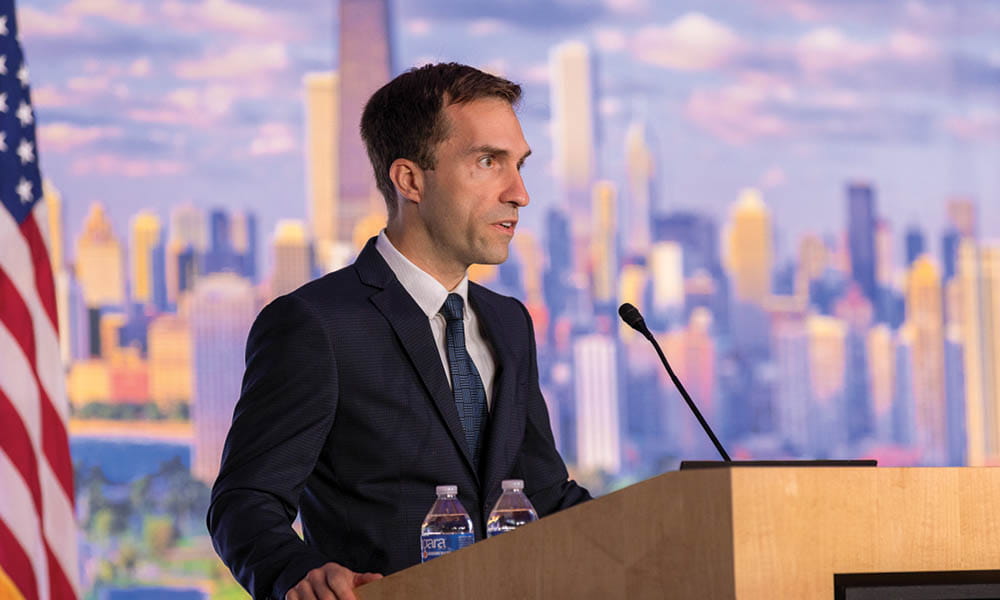
This advocacy continues, and Ambrosi focused on the Association’s ongoing fight against reduced-crew operations (RCO) and the continuing battle for secondary barriers—the latter especially timely, as he spoke on the eve of the 24th anniversary of the 9/11 terrorist attacks.
Ambrosi stated that combatting the threat of RCO has been a key priority during his time in office and vowed to continue advocating against it. “I’ve said it before, but it’s worth repeating again: the most important safety feature on any airliner is at least two well-rested pilots on the flight deck at all times.”
He urged airlines to begin implementing mandatory secondary barriers on all new passenger airliners as quickly as possible. Ambrosi lauded ALPA’s years of work advocating for the required installation of secondary barriers and vowed to continue pressing to stop any further implementation delays.
“The barriers exist and are already being installed on aircraft,” he stated, “so the fact that we’re still debating whether to install basic flight deck protections more than two decades after the terrorist attacks is inexcusable.
“When I look at the people gathered in this room,” Ambrosi said in closing his remarks, “I see the reason more than three million passengers and 61,000 tons of cargo reach their destinations safely every day. I see the reason aviation is the safest form of transportation in the world. And I see the people who will make sure another tragedy like PSA Flight 5342 doesn’t happen again.”
Canadian TSB Chair Calls for Collaboration
“As chair of the Transportation Safety Board [TSB] of Canada, I’m proud to represent an organization that’s committed to preventing accidents and improving transportation safety, a goal that I’m sure we all share,” remarked Yoan Marier during his Wednesday afternoon keynote address. “Achieving this goal requires one key element—collaboration. As an industry, our collective effort toward safety, defined by the challenge we face and the progress we make, is how we can truly make a difference.”
Marier observed that the TSB has been in operation for 35 years and, during that period, has completed more than 2,000 investigative reports, released hundreds of safety communications, and issued more than 630 recommendations—noting that 84 percent of the agency’s recommendations have been closed.
He attributed this outstanding performance to the relationships his organization has established with other aviation industry stakeholders and the subsequent benefit of sharing information. “When information is shared, it opens the door for immediate proactive measures that can prevent further occurrences and ultimately save lives,” Marier remarked.
He spoke in depth about a safety study investigating 27 runway incursions at Toronto Pearson International Airport, focusing on two closely spaced parallel runways—a facility area known as the South Complex. “A report for this investigation was published more than five years ago, and it included multiple recommendations to Transport Canada and to the Greater Toronto Airport Authority,” he noted.
While Transport Canada opted not to act on a recommendation to amend certain standard operating procedures, including one to delay landing checks until an aircraft is clear of both runways when they’re active, the situation has improved thanks to an alternative resolution. “We found that the risks identified in these recommendations have been significantly reduced through proactive action by the industry and other key players,” said Marier.
“As we collaborate on how we can move forward together, it’s important to remember that the spirit of this collaboration also extends beyond borders,” he commented. “Like our NTSB colleagues here in the United States, the TSB regularly works with international organizations and agencies, sharing knowledge, expertise, and insight to improve safety on a [larger] scale.
“Safety is a shared responsibility,” Marier stated, adding that when different stakeholders join forces, they promote a broader safety culture and a safer, more efficient operation.
“State of the Industry” Discussion with Labor Leaders
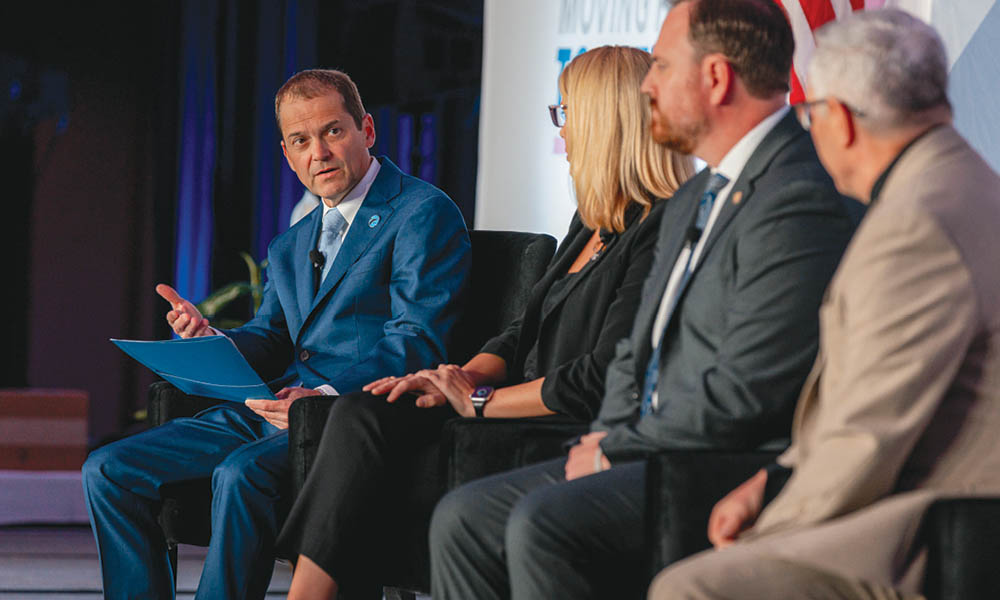
Ambrosi returned to the stage to lead a panel discussion with aviation industry labor leaders. Joining him for this discussion were Sara Nelson, president of the Association of Flight Attendants-CWA; Nick Daniels, president of the National Air Traffic Controllers Association (NATCA); and Dave Spero, president of the Professional Aviation Safety Specialists (PASS).
He began by emphasizing the importance of these organizations’ frontline workers in contributing to aviation safety. “In our jobs,” Ambrosi said, “workers see what works and what doesn’t, and it’s up to our unions to protect the right of workers to speak up for safety.”
The wide-ranging discussion touched on the state of the aviation industry today, how the government transition is affecting the work that members of each union do, how the unions are advocating for safety and security in a changing landscape, and what each union is focused on for the remainder of 2025 and into 2026.
Nelson emphasized the expertise that workers represented by each union bring to the table. “Safety starts and ends with us,” she asserted. Nelson observed that some of the issues currently facing the industry are the result of a “failure to invest” in aviation.
Daniels expanded on that, pointing to the threat of a potential government shutdown and how even that threat can stop important programs and projects from continuing, with a ripple effect that could extend far into the future. And in the immediate term, he said, “It will be less safe each and every day” if a shutdown does occur.
Spero provided a concrete example of how just that threat affects his members. He stated that PASS is short by roughly 1,000 workers, “one of the lowest points ever,” and while the FAA is finally ready to hire and train more, a shutdown not only stops that training but even the threat can cause those workers to rethink their career choice and go elsewhere.
The group also discussed the threat of RCO and the need to implement secondary barriers. “Flight attendants aren’t working a single airplane if there’s one pilot on the flight deck,” Nelson said to applause.
Her words regarding secondary barriers were even stronger, pointing out that current practice essentially puts a flight attendant’s body on the line “to save a few pieces of silver.”
All agreed that working together toward a shared goal of safety is paramount. “We’re all going to have to work together to make a safe system safer,” Ambrosi concluded.
Panel Examines How to Strengthen Safety Culture in Aviation
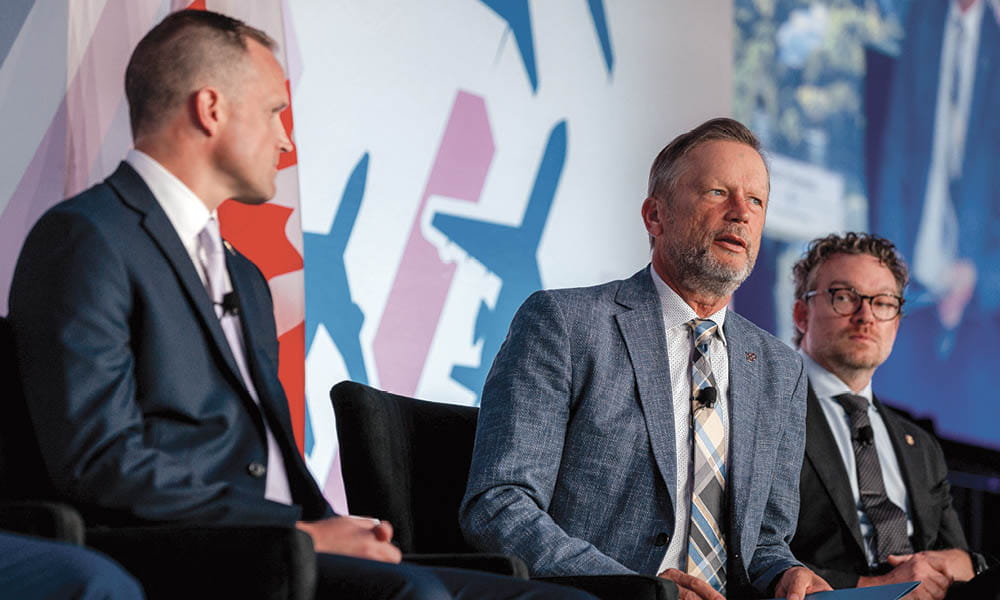
Aviation safety advocates convened to discuss the importance of strengthening safety culture. The panel “Strengthening Safety Culture in Aviation: How Do We Improve Trust, Leadership, and Risk Management?” brought together diverse perspectives on how to sustain and improve the foundation of airline safety.
Moderated by Andrew Tangel, an aviation reporter for The Wall Street Journal, the panel featured Capt. Steve Jangelis (Delta), ALPA’s Aviation Safety Group chair; Capt. Robert Thomas, United Airlines’ vice president of Flight Operations Planning and Development; Mark Millam of the Flight Safety Foundation; and John Murdock, NATCA’s Safety chair.
Participants emphasized that a strong safety culture goes beyond regulatory compliance. It requires a shared, organization-wide commitment to prioritize safety above competing business pressures. Central to that culture is trust in the nonpunitive use of safety data to ensure that pilots and other frontline employees remain engaged in the safety risk-management process.
“From ALPA’s perspective, a culture of safety allows an employee to report safety issues and risks and point them out to their employer and to the regulator,” said Jangelis. “This ensures that they can find mitigations and safely integrate and implement changes into the system and the operation.”
Employee engagement is key to sustaining that reporting culture, but it only works if management demonstrates, through action, that safety truly comes first. Panelists agreed that fostering mutual respect between labor and management is essential to ensuring that pilots, controllers, and other aviation professionals feel confident in raising safety concerns.
“A just safety culture encourages reporting, creating opportunities to learn and improve rather than to assign blame,” said Millam. “And once that’s experienced, the workforce really begins to learn that honest mistakes get treated fairly, and invaluable information starts to flow to empower other folks to learn and improve.”
The panel also noted that the strength of a safety culture can vary among airlines and that leadership plays a decisive role in setting the tone. Transparent policies, consistent training, and reinforcing safety behaviors are critical in sustaining a culture in which employees feel empowered to speak up. The importance of mentorship and leadership development was also highlighted as a way to reinforce safety values.
Participants agreed that maintaining a healthy safety culture requires vigilance, adaptability, and, above all, a shared commitment from every stakeholder.
AI in Aviation: Benefit or Liability?
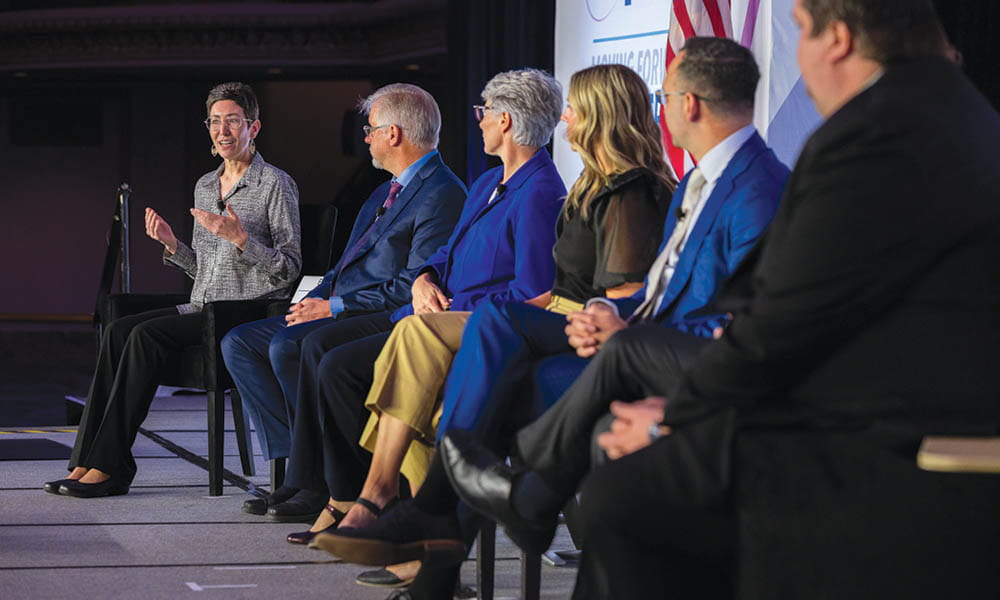
Artificial intelligence (AI) remains a topic of great interest, and ALPA’s Air Safety Forum took a critical look at this controversial technological development with a panel titled “AI in Aviation: What Can We Do and What Should We Do? Advancing Technology While Advancing Safety.” Moderated by The Air Current’s Elan Head, panelists examined how AI is currently being used in the airline industry, its strengths, and its weaknesses.
Prof. Amy Pritchett, who heads Penn State University’s Department of Aerospace Engineering, defined AI as “computational systems that learn complex patterns,” including those in words, sounds, images, and data. She noted that AI is incapable of handling situations it wasn’t trained to address, adding that “Part 121 has such a good safety record that you’ve set a very high bar for new technology to come in.”
There’s an important difference between automation and AI. Steven Beland, a retired Boeing employee and an aircraft and system safety assessments subject-matter expert, noted that automation refers to the use of technology to perform repetitive tasks whereas AI provides cataloging, analysis, and, within limited parameters, decision-making. With AI’s current “reliability threshold,” he observed that it’s a long way from being dependable enough to be included in onboard aviation equipment, but “It’s worth continuing to research.”
“The information you give [AI] can result in problems based on inconsistencies,” asserted Kyle Quakenbush, principal aviation system engineer with the MITRE Corporation. He stressed the need to ensure that the data being studied is both appropriate for the application and accurate. Without the necessary protections in place, the conclusions AI draws could be misleading or erroneous.
Capt. Chris Sidor (United), ALPA’s Aircraft Design & Operations Group chair, highlighted that, in AI’s current state of development, “The algorithms in place aren’t reliable.” He added that the technology has great possibilities and that, in the future, this application could be well suited for assisting pilots with basic tasks and improving operational considerations like situational awareness.
Capt. Monica Frain, senior manager of United Airlines’ Flight Operations Safety and Fatigue in Aviation Safety programs, noted that the airline is using a form of AI to process safety and performance data, adding, “It allows us to identify problems at a broader level.” However, she continued, “It’s only as good as we’ve trained it to be.” Human analysts are still needed to ensure that the information is processed correctly and AI is applying the proper assumptions.
Providing an air traffic control perspective, Murdock reported that controllers aren’t currently using AI in their daily operations but that the use of this technology is under consideration for analyzing and summarizing future operational reports.
The Continuing Evolution of Aviation Security
Aviation security took center stage with Thursday’s panel discussion “From Checkpoints to Flight Decks and Beyond: An All-Encompassing Look at Aviation Security.”
Moderated by Allison Sider, an air travel reporter for The Wall Street Journal, the panel included Capt. Wolfgang Koch (Delta), ALPA’s Aviation Security Group chair; Capt. Mike Karn, American Airlines’ senior manager of Flight Operations Security; Scott Krueger, an FAA senior technical advisor for Aviation Safety; and Cassie Rooney, a Boeing B-737 interiors chief engineer.
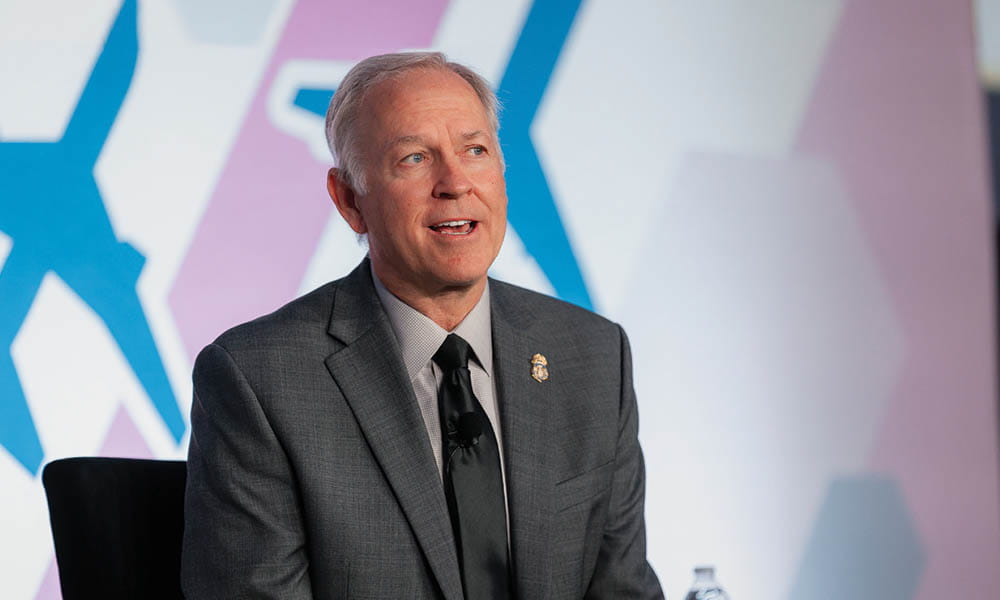
With the panel taking place 24 years to the day of the 9/11 terrorist attacks, the conversation started with the evolution of security threats and needs since that day.
Karn highlighted the “ripple effects” the attacks caused in the United States and in the industry in explaining why aviation is still a high-priority target for bad actors. Koch remarked that Al Qaeda remains a security concern, but also noted cargo vulnerabilities, the insider threat, and UAS as current concerns as well.
Karn and Koch also discussed the evolving threat of cybersecurity, not just on the aircraft but within operating systems as well. “Attack modes and capabilities continue to evolve,” said Karn, and security must as well.
Disruptive passengers have become an increasing security concern since the start of the pandemic and continuing through current day. Krueger shared FAA data on the growing security concern of unruly passengers, outlining the steps the FAA has taken to address the issue and stressing the need for cooperation and timely reporting.
He provided statistics showing that in the decade leading up to the pandemic there were roughly 1,400 recorded instances of unruly passengers, while 2021 saw more than 1,000 in just one year. Krueger reviewed FAA actions to address this concern, including a focus on criminal and civil penalties, and stressed the need for prompt and accurate reporting from the flight crew.
Koch emphasized the effect unruly passengers can have on the crew. “It’s a disruption to routine and a degradation of safety,” he stated, pointing out that the increase in unruly passengers is yet another reason secondary barriers need to be implemented. “There are constant attacks on the flight deck,” explained Koch, “and we need this system to protect the aircraft.”
Rooney reviewed the legislative path regarding secondary barriers. She added that Boeing has been working with its U.S. customers to understand their needs regarding the barrier and reported that Boeing has been receiving feedback from pilots who’ve flown with secondary barriers stating that they feel safer.
Koch also emphasized the need for a primary barrier on cargo flights, noting that there’s still no primary flight deck door on these flights that often include passengers.
Other topics discussed included working to establish a system in security similar to the Safety Management System, the need to create a just culture in security to allow for increased reporting, and the continuing evolution of the Known Crewmember program.
Prioritizing Safety in the Rapidly Advancing Airspace System
Industry, labor, and government leaders examined one of aviation’s most pressing challenges during the discussion “Navigating the Skies: Safely Integrating Current and New Users into the National Airspace.” Panelists explored the operational implications of commercial space launches, supersonic transport, drones, and electronic vertical takeoff and landing aircraft. Each of these technologies is moving rapidly toward widespread use, with clear benefits for mobility and innovation, but also with significant demands on airspace, airports, and infrastructure.
Moderated by Head, the discussion featured Capt. Tanner Furr (Delta), an ALPA commercial space operations subject-matter expert; Dallas Brooks from Wing Aviation; Capt. Jim Webb from Boeing; Akbar Sultan from NASA; and Paul Behan from NATCA. Panelists stressed that “safe integration” must move beyond a buzzword to become a concrete framework for managing operations and protecting the traveling public.
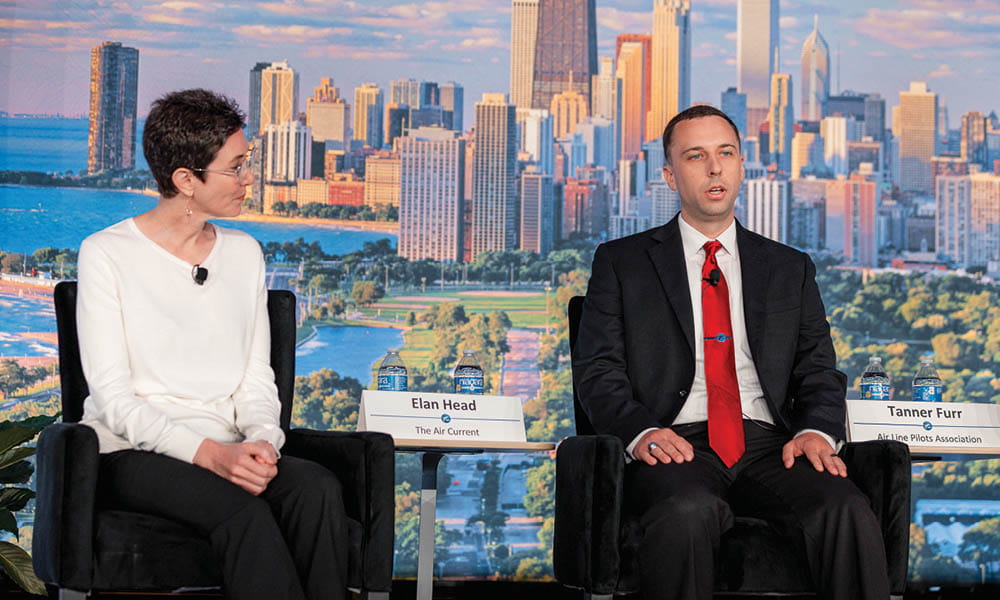
From supersonic flight promising global connectivity to drones already numbering more than a million in the United States, the panel underscored the urgency of collaboration.
“A common misconception that I’ve heard lately is the idea that commercial space vehicle integration into the national airspace system is a challenge that’s five years down the road,” said Furr. “It’s not five years away. It’s not two years away. It’s right now.”
Panel members emphasized that while the technologies themselves are groundbreaking, the regulatory and procedural frameworks that govern their operation are still developing. Collaboration among operators, regulators, and labor groups is essential to avoid piecemeal approaches that could compromise safety or efficiency.
“I think the biggest thing that keeps me concerned about this particular topic is whether we can incorporate reliable technology with enough foresight and with enough data to make our overall airspace safer and better,” Webb commented. “But I’m excited about it because I think the technologies that come from this type of work can be incorporated into the commercial aircraft world to help enhance situational awareness.”
The discussion also examined the infrastructure demands that come with new aviation concepts. Without early planning and cooperation, the potential exists for challenges that could limit both safety and growth.
Throughout the conversation, panelists highlighted that safety isn’t an obstacle to innovation but the foundation upon which it must rest. The group called for continued investment in research, standards development, and cross-sector collaboration, while urging policy makers to take a measured, step-by-step approach to integration rather than rushing toward deployment.
Changing the Way We Look at Fitness
Assessing fitness for duty, as it relates to airline flying, has evolved into a more complex deliberation thanks to the significant advancements made in medicine and the greater understanding of physical and mental health. Overall wellness is paramount to aviation safety and yet, due in part to often-unfounded fears of potentially career-ending diagnoses, some pilots may avoid seeking help when confronted with symptoms of health concerns.
These considerations were explored in the panel discussion “Proactive Approach to Pilot Wellness: Fitness for Duty, Practical Tools.” Moderated by F/O Chris Arnold (United), ALPA’s Pilot Assistance Group vice chair, panelists offered insights into the evolving aeromedical environment and new considerations for staying fit to fly. “Our goal today isn’t just to inform; it’s to empower,” he said.
Dr. Gregory Ostrom, a senior aviation medical examiner (AME), underscored the challenges of being objective about your health. If your body doesn’t alert you to let you know help is needed, you may not know to seek it. That’s why it’s so important to regularly see a primary-care physician. Ostrom clarified with forum attendees that “an AME isn’t a primary-care physician.”
“Who do you trust most in the world? It’s yourself,” said F/O Carrie Braun (JetBlue), ALPA’s Pilot Peer Support program chair. “You have a bias to believe yourself,” she commented, adding that it’s important to get out of that comfort zone and listen to friends and family who may detect changes in your mood, appearance, or personality that could reflect a problem. “We’re really bad at looking at ourselves, but we’re really good at looking at each other,” she observed.
For those who may not have a family or community of friends who can provide that attention, F/O Rick Mahoney (Delta), ALPA’s Aeromedical Committee chair, remarked that there needs to be a way to reach pilots who may be suffering from different kinds of conditions. He discussed the importance of taking a proactive stance to keep pilots healthy before challenges can sidetrack their careers. “Pilots are human beings,” Mahoney noted, adding that they’re subject to the same limitations as everyone else.
F/O Julie Love (Spirit), an ALPA aeromedical subject-matter expert, drew special attention to women’s health issues, pointing out, “AMEs are working within a framework that wasn’t originally designed with women in mind.” Consequently, health considerations for women may often go unaddressed. Love identified a new ALPA resource in development, the Women’s Health Resource Group, to bring attention to these concerns.
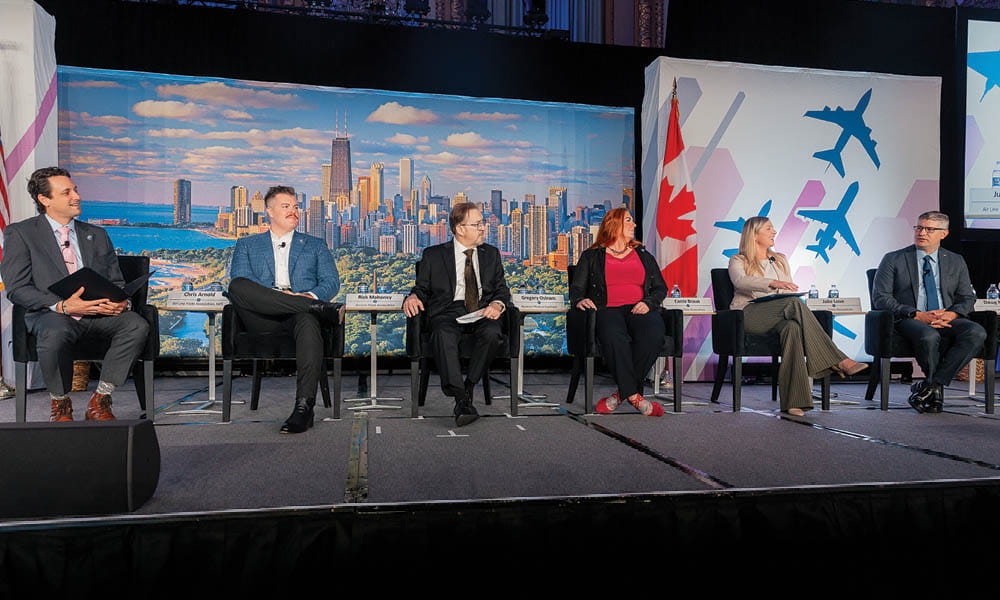
“Understanding what you need” is the key to optimizing your performance said Capt. Doug Marchese (JetBlue), ALPA’s Flight Time/Duty Time Committee chair. Exercise, a healthy diet, and sufficient sleep are important, but there are other key factors—“personal things that work for you to reduce your stress”—that can help you function at your best. Irritability and a decline in your decision-making and cognitive abilities can be a manifestation of fatigue and should prompt you to question whether you’re fit to fly.
Using New Technology to Supplement Training
The panel “Balancing Innovation and Traditional Training: Training the Current and Next Generation of Airline Pilots” took an in-depth look at how advanced technologies can assist with pilot training and how some airlines are already using it today.
Moderated by Capt. Randy Symanski (Spirit), ALPA’s Training Council chair, the panel members included Capt. Logan Shamoon (Envoy Air), his pilot group’s Training Committee chair; F/O Raymond Hicks, Envoy Air’s manager of Training Delivery; Capt. Josh Assayag, United Airlines’ managing director of Flight Standards; and Capt. Bryan Burks (Alaska), a member of his pilot group’s Human Factors & Training Committee.
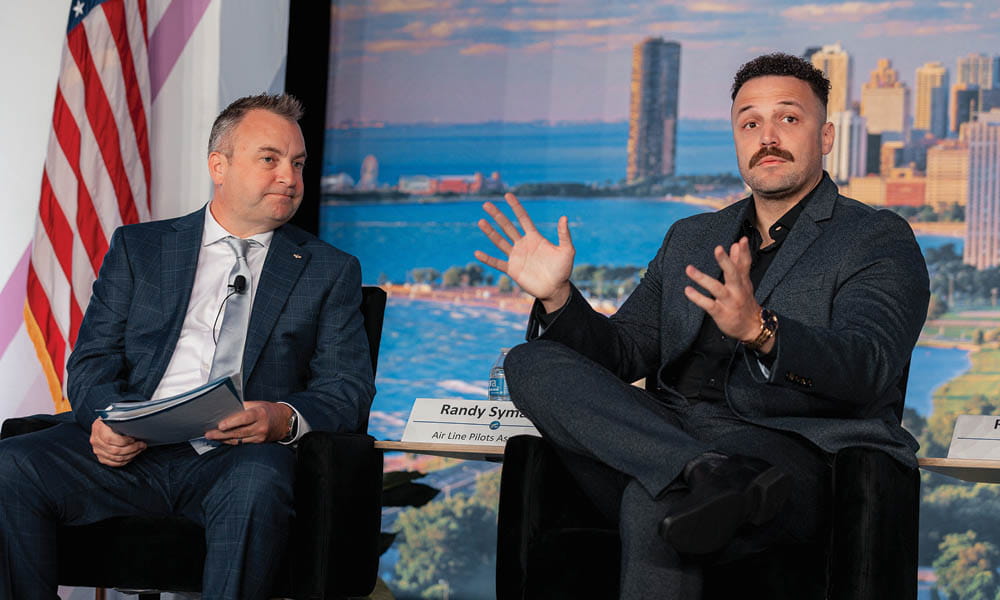
Symanski began the discussion by stating that this isn’t a debate between new technology and the old ways of doing things. “This is about using the right tool for the right task and at the right time,” he said, “and proving that it makes pilots safer on the line.” Symanski observed the panel’s aim was to discuss where emerging tools can help, where they don’t, and how they can be implemented without degrading safety. “Integration and not substitution,” he stated.
Hicks detailed how Envoy is currently using virtual reality with its training—not as a replacement but as an addition to the airline’s efforts and explained how it’s enhanced pilot safety.
Shamoon reported that the feedback on the additional training has been very positive, both from the pilots taking the training and from the instructors. “The immersion of this is fantastic,” he said. “Pilots can sit inside the flight deck or walk around the aircraft—something they haven’t been able to do with training tools leading up to this point.” They can see the effects of a bird strike, he continued, not just a photograph.
Shamoon cautioned that virtual-reality training doesn’t provide the tactile aspect or a sense of motion but noted that using the system for flows and callouts can help get pilots used to the aircraft so the next steps in training are even more valuable.
Assayag discussed how United Airlines is utilizing new technology as well, with early use of high-fidelity fixed-training devices to better prepare pilots for the full-motion simulator. He also referenced the use of AI to help bring what pilots might see on the line into their training.
Hicks also emphasized the importance of ALPA involvement, noting that Envoy Air has a collaborative relationship with ALPA and includes the Association from development to delivery. Having ALPA on board, he said, greatly increases buy-in from the pilots.
Burks spoke about the importance of standards and guidance in training technology. He referenced International Civil Aviation Organization guidance on qualified training devices and programs and stressed the need to avoid a “check-the-box” approach when looking to implement new training devices and selecting improvements. Burks stated, “There absolutely are benefits,” but stressed the need to be measured and careful. “We must be prepared as an Association.”
“Full-motion simulators remains the anchor,” concluded Symanski, but tools can supplement these simulators and make pilots safer.
Fireside Chat Highlights NTSB Chairwoman’s Thoughts on Aviation Safety
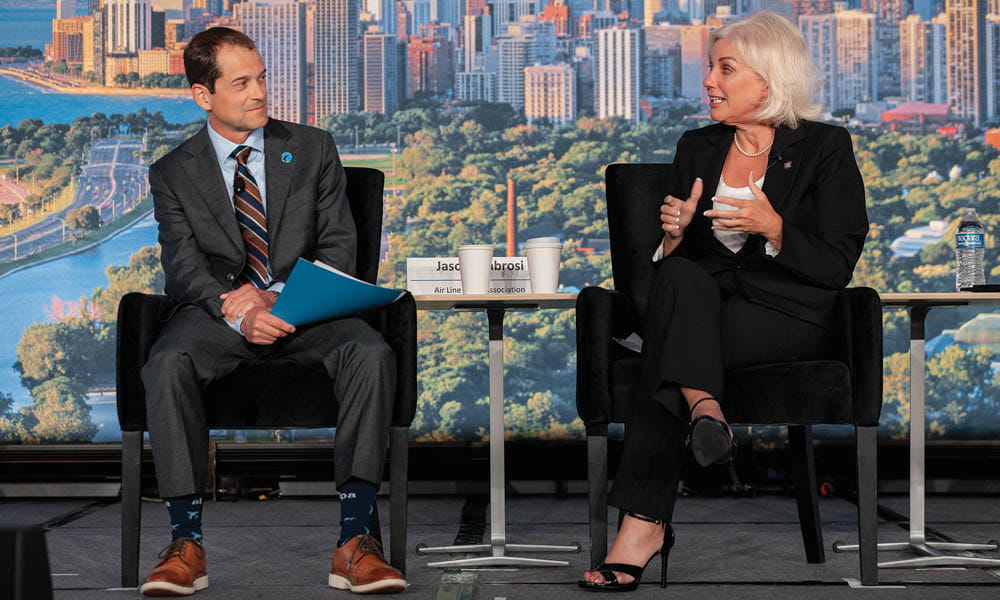
In the final segment of the Air Safety Forum, Ambrosi sat down with NTSB Chairwoman Jennifer Homendy for a fireside chat. The two covered a host of topics, exploring current transportation safety issues and the tremendous support and advocacy Homendy has provided ALPA and airline pilots since her appointment.
Ambrosi opened the discussion, asking Homendy about the status of the accident investigation of PSA Flight 5342. “We’ve pretty much concluded our fact-finding portion of the investigation,” she said, adding, “Almost all of our investigative documents are open to the public on the public docket, which you can get to on our website.” Homendy noted that the agency is transitioning to the analysis stage of the investigation with the goal of completing the process by the anniversary of the accident.
Ambrosi asked the NTSB chair to walk through the different stages of a typical accident investigation and explain how the board designates organizations like ALPA as parties to the investigation to provide technical expertise. She also noted that, as of October 1, the NTSB will redact the names of crewmembers from the agency’s public documents. “It’s their safety that’s important, too,” she said, pointing out the potential harm of circulating these names before an investigation can be completed.
Homendy reiterated her support for maintaining two pilots on an airline flight deck, citing several near-miss incidents including the FedEx Express/Southwest near-collision in Austin, Tex., in February 2023 (see the November‒December 2023 issue). She remarked that she couldn’t imagine how those accidents could have been avoided with only one pilot on the flight deck.
Of more recent concern, Homendy referenced the Air India Flight 171 accident near Ahmedabad Airport on June 12—noting that within hours, an AI-generated video depicting the crash from the flight deck was circulated on television news programs. Many initially thought the recording was real. She commented that while AI has many positive uses, it’s also creating problems.
When asked if she had any other concerns she’d like to raise, Homendy stated, “We’re not doing enough on [pilot] mental health.” She highlighted the Mental Health and Aviation Medical Clearances Aviation Rulemaking Committee and its 24 recommendations. While some were covered in the latest FAA reauthorization legislation, she asserted, “We have so much more to do.”
A Recognition and a Celebration
“This forum is both a recognition and a celebration of the hard work that goes into every inch that we move forward to keep our skies safe and secure,” Ambrosi acknowledged. “Since the first flight, aviation has been a pinnacle of human achievement and innovation, but anyone who’s worked on improving safety can tell you, progress takes time and determination.”
That determination was on full display at ALPA’s 69th Air Safety Forum.
More from the 69th Air Safety Forum
The Air Safety Forum kicked off with private meetings of the various councils, committees, and groups that support the ASO's four pillars: Safety, Security, Pilot Assistance, and Jumpseat.
The annual Air Safety Forum Awards Banquet highlighted the outstanding accomplishments of ALPA pilots.
Falling on the 24th anniversary of the September 11 terrorist attacks, the Air Safety Forum served as a reminder that the Association's safety work is never done.












